The focus was on central banks, creating scary-looking charts


Friday’s stock trading in New York ended in about minus 1% for the S&P500 index, influenced by the Fed’s signals of several rate hikes in 2022 and omicron. There have been twenty-one thousand cases of omicron infection recorded in New York state, which was hit hardest in the United States during the pandemic in 2020.
In this weekly trading note from Carlsquare, we elaborate on the following topics, indices, and stocks:
- The scary technical situation in S&P 500
- Risk also found on the downside in Nasdaq
- Yet another scary looking chart for Alphabet
- Tesla is still in trouble
- Cantral banks did not manage to create volatility in EUR/USD
- Scarry looking Doji in gold
- Big move ahead for OMXS30?
- DAX may join in on the big move
Friday’s stock trading in New York ended in about minus 1% for the S&P500 index, influenced by the Fed’s signals of several rate hikes in 2022 and omicron. There have been twenty-one thousand cases of omicron infection recorded in New York state, which was hit hardest in the United States during the pandemic in 2020.
As can be seen below, the short-term trend is down for virtually all stock market indices, except the FTSE (London Stock Exchange), which contains many food and pharmaceutical companies with lower cyclical exposure. It could indicate that investors have begun to discount an economic slowdown, combined with slightly higher interest rates. But it could also be a take profit-related rebound after a long period of price rises.

Source: www.di.se, www.marketwatch.com
Investors’ primary focus, apart from omicron, has been the central banks’ announcements last week and, in particular, the Fed’s. The US has significantly higher interest rates than the Eurozone and is also leading the way for now. The Bank of England is closer to the Fed in its interpretation with a 0.15 percent interest rate hike last week, while the ECB seems to want to continue stimulating during 2022 and possibly longer than that. Could it be that support for the Eurozone garlic belt (such as Italy and Spain, and to some extent also France) is guiding the ECB’s policy decisions? Keeping all the major countries of the monetary union happy might be more important than anything else. The difference with the Fed’s message could argue for higher interest rate differentials between the US and Europe going forward and, above all, continued low-interest rates in Europe. But also Fed seemed hesitant, giving one message in their rate decision followed by Powell mitigating it at the following press conference.

Source: Refinitiv Eikon
Credit Default Swap prices for Italian 5-year government bonds have gone up slightly in recent weeks. However, from a longer-term perspective, the movements are small. In 2012 and 2013, CDS prices of Italian 5-year government bonds were quoted just above 500. The same is for the French and Spanish CDS.
As for economic data, they are currently pointing to a modest slowdown. US industrial production in November, which rose by 0.5% against an expected 0.6% month-on-month, point to this. Similarly, in December, the Eurozone’s Flash composite purchasing managers’ index fell to 53.4 from 55.4 in November. At the same time., the recovery in US employment continues at a reasonable pace.
President Biden’s stimulus program, with a strong focus on infrastructure in various forms, is about to be rolled out in the US, though peak spending will occur in 2023. There is a debate in the US about the impact of this stimulus program. Supporters point out that the program will support improved productivity in the US business community. Critics argue that these stimulus measures might boost an already high inflation rate.
Fed’s Powell has painted himself into a corner by saying that some of today’s inflation is not transitory. It also means the Fed will have to act by raising rates in 2022 unless they want to lose their credibility, all else equal.

Source: Refinitiv Eikon
As measured by US 10-year Treasury bonds, the trend in yields right now is downward. The US 10-year yield fell seven points on Monday, December 13, to 1.41 percent before rising to a high of 1.46 percent on Wednesday evening on the Fed’s interest rate announcement. On Thursday and Friday (16-17 December), the US 10-year yield then fell back to 1.41%. In isolation, the rise in interest rates does not appear to be a significant threat to equity valuations now.
The charts are looking scary with falling momentum. May the sentiment turn, or this can be a dull Christmas for long traders.
S&P 500 closed Friday, December 17, down by 1.0%. The index closed down of a bearish rising wedge formation, indicating that levels around 4 750 can be next. A trigger is if both MA50 and MA100 break on the way down. Note how the index rebounded intraday off MA50 on Friday.

Source: Refinitiv Eikon and Carlsquare
In the weekly chart, the S&P 500 index is still trading above rising EMA9 and MA20.
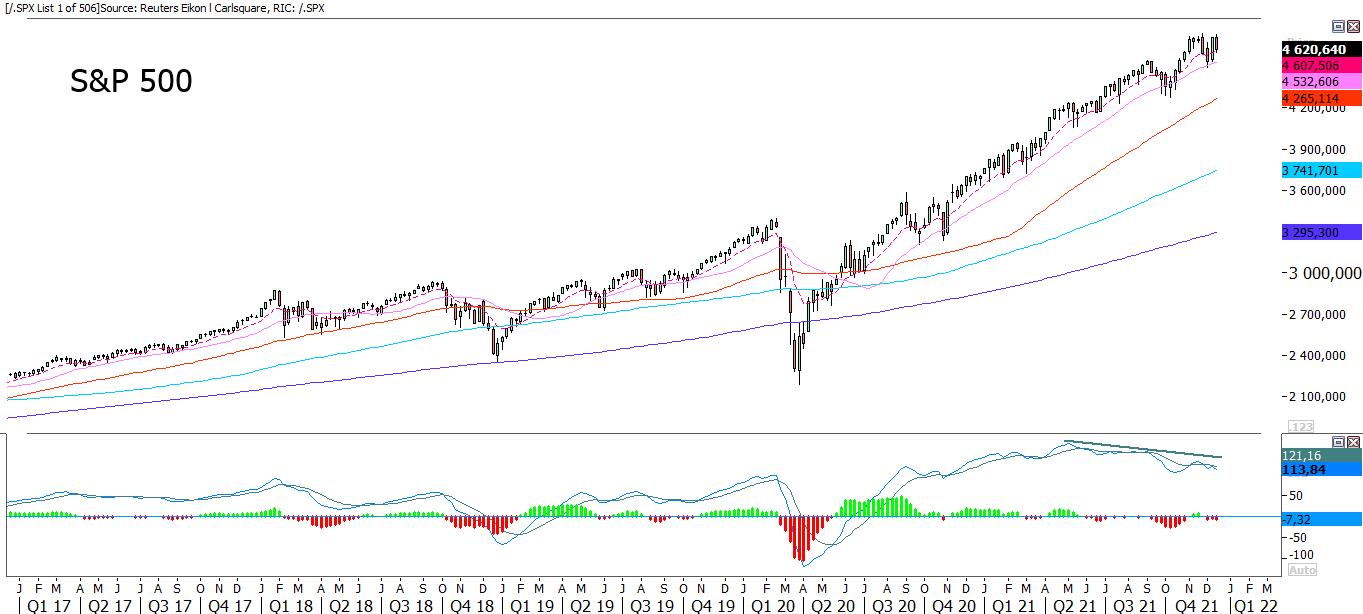
Source: Refinitiv Eikon and Carlsquare. Note: Past performance is not a reliable indicator of future results.
Nasdaq 100 fell 0,4% on Friday and is currently balancing on a neutral wedge formation floor. The formation indicates that MA200 presently trading around 14 683 is in sight. Also, note that MACD is close to a sell signal.

Source: Refinitiv Eikon and Carlsquare
In the weekly chart, Nasdaq closed last week below EMA9 but found support at a rising MA20.
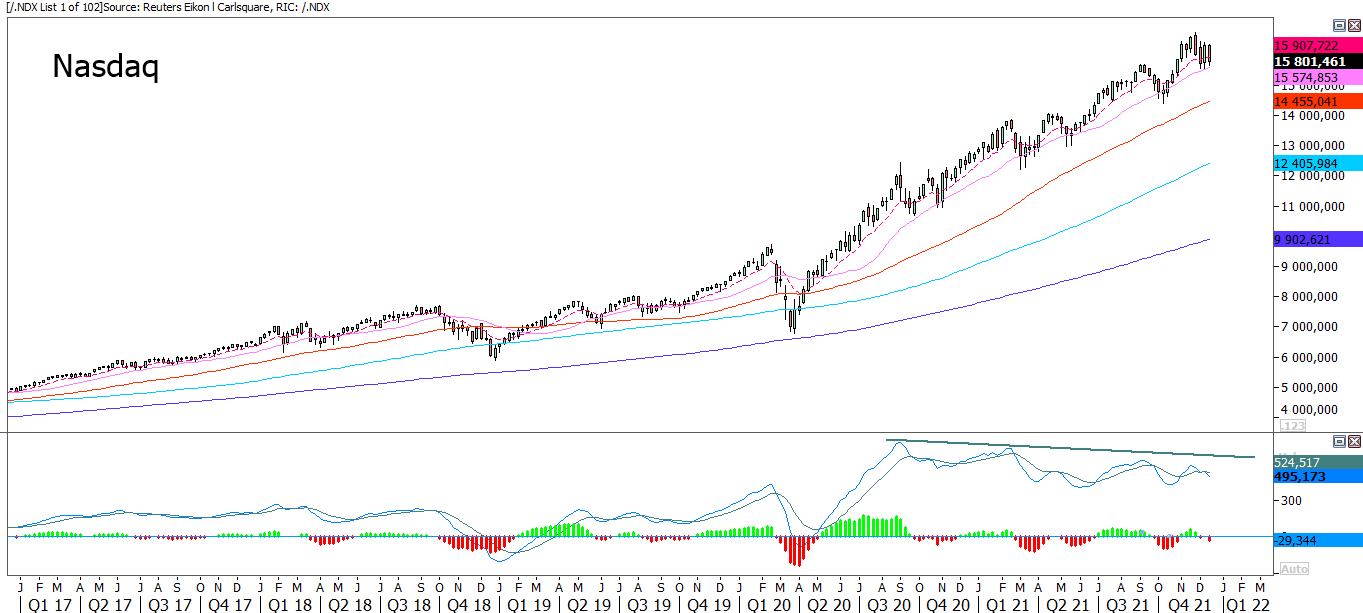
Source: Refinitiv Eikon and Carlsquare. Note: Past performance is not a reliable indicator of future results.
Alphabet share closed Friday below the floor of the rising trend right around MA100. The next level for support of the share price is found around 2 775 USD. MACD is not looking happy.
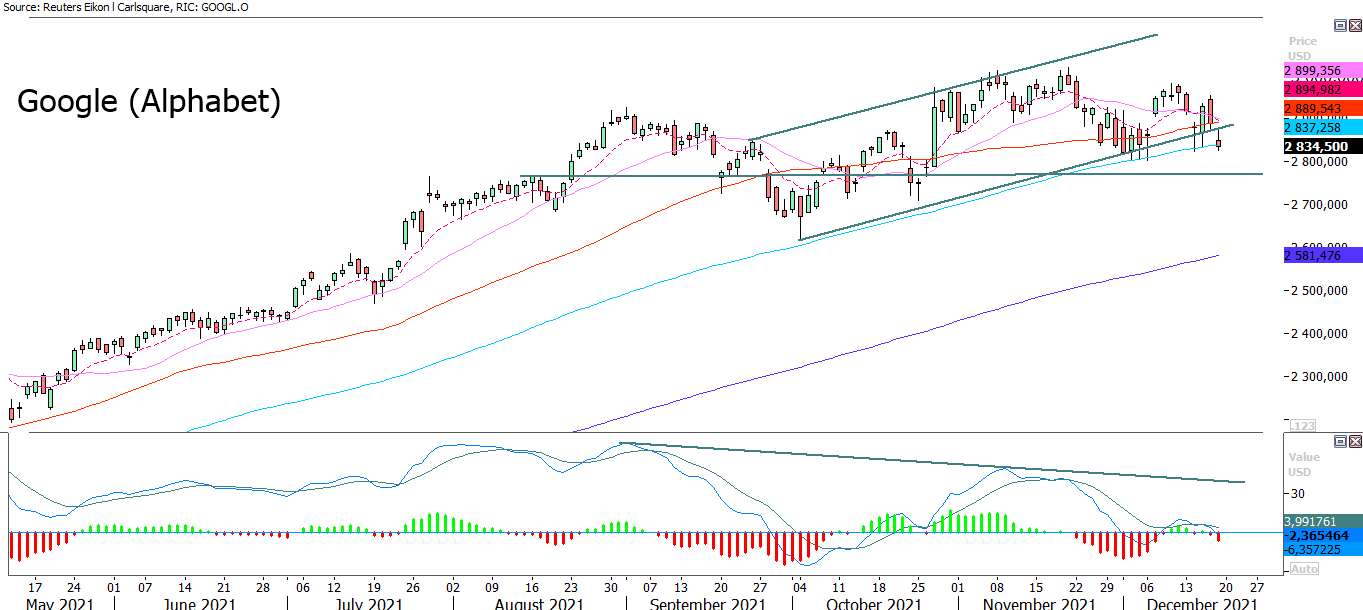
Source: Refinitiv Eikon and Carlsquare
In the weekly chart, Alphabet closed below EMA9 and MA20. Again, MACD is not looking happy.

Source: Refinitiv Eikon and Carlsquare. Note: Past performance is not a reliable indicator of future results.
Tesla did go against the flow and closed Friday’s trading up by 0.6%. However, EMA9 and MA20 are falling and putting pressure on the share from above. Is MA100 currently trading at 878 USD next?
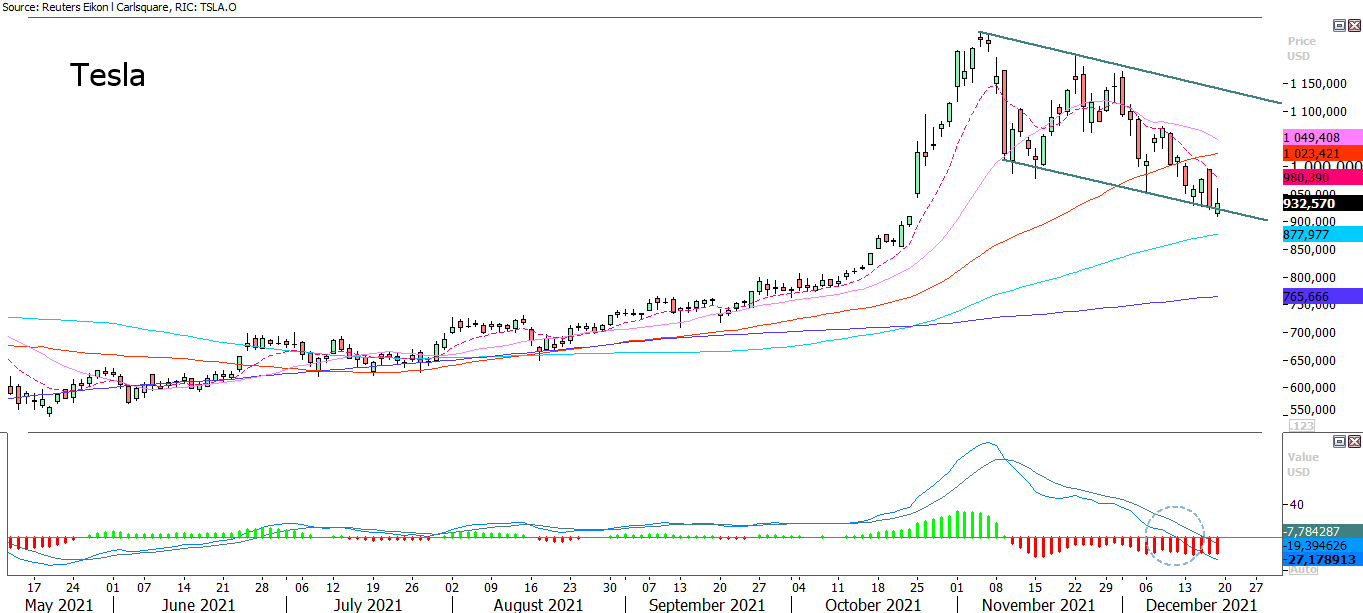
Source: Refinitiv Eikon and Carlsquare
There is still some downside in the weekly chart before the gap has been closed.

Source: Refinitiv Eikon and Carlsquare. Note: Past performance is not a reliable indicator of future results.
EUR/USD is still consolidating in its range. Thus, central banks did not help decide any direction for the currency pair.

Source: Refinitiv Eikon and Carlsquare
For some excitement, one will have to go to the weekly chart. Note how the currency pair closed last week well below Fibonacci 61.8.

Source: Refinitiv Eikon and Carlsquare. Note: Past performance is not a reliable indicator of future results.
A scary-looking Doji appeared in the gold price graph on Friday. There is a cluster of support levels on the downside. However, given continued strength in the USD, it is easy to break this cluster.
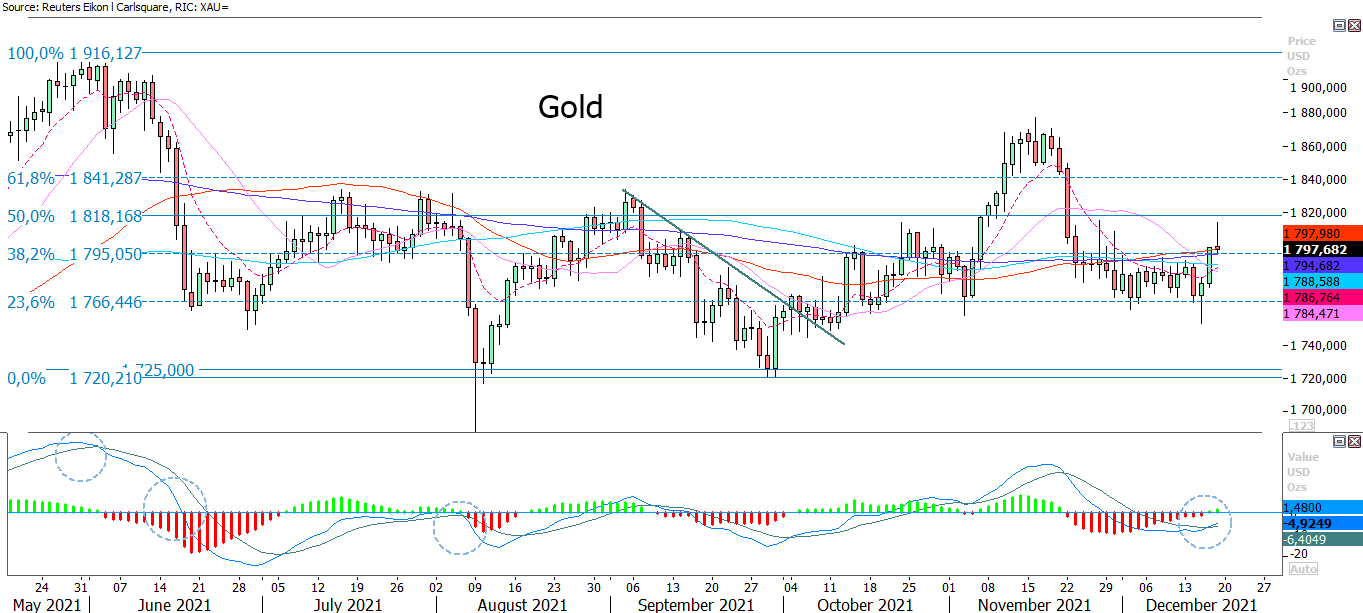
Source: Refinitiv Eikon and Carlsquare
In the weekly chart, gold is consolidating in a neutral wedge formation.

Source: Refinitiv Eikon and Carlsquare. Note: Past performance is not a reliable indicator of future results.
Swedish OMXS30 index is consolidating in a relatively sizeable neutral wedge formation. A break on the up-or downside and the shape calls for a significant move in the same direction.

Source: Refinitiv Eikon and Carlsquare
In the weekly chart, one can see how OMXS30 is supported from below by rising MA50. Again, momentum is not looking too happy.

Source: Refinitiv Eikon and Carlsquare. Note: Past performance is not a reliable indicator of future results.
As OMXS30, the German DAX index also trades in an extensive neutral wedge formation. Let us hope for a big move to come and that the proper position is on.

Source: Refinitiv Eikon and Carlsquare
In the weekly chart, MA50 still serves as support on the downside. Momentum is falling as visualized by MACD.

Source: Refinitiv Eikon and Carlsquare. Note: Past performance is not a reliable indicator of future results.
EMA 9: 9-day exponential moving average
Fibonacci: There are several Fibonacci lines used in technical analysis. Fibonacci numbers are a sequence of numbers in which each successive number is the sum of the two previous numbers.
MA20: 20-day moving average
MA50: 50-day moving average
MA100: 100-day moving average
MA200: 200-day moving average
MACD: Moving average convergence divergence